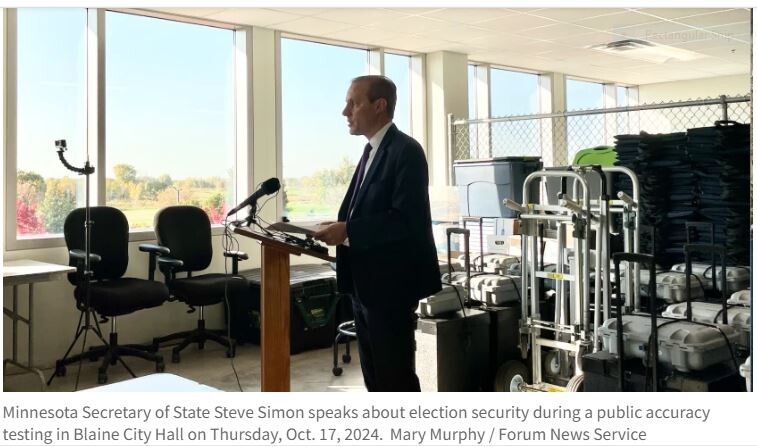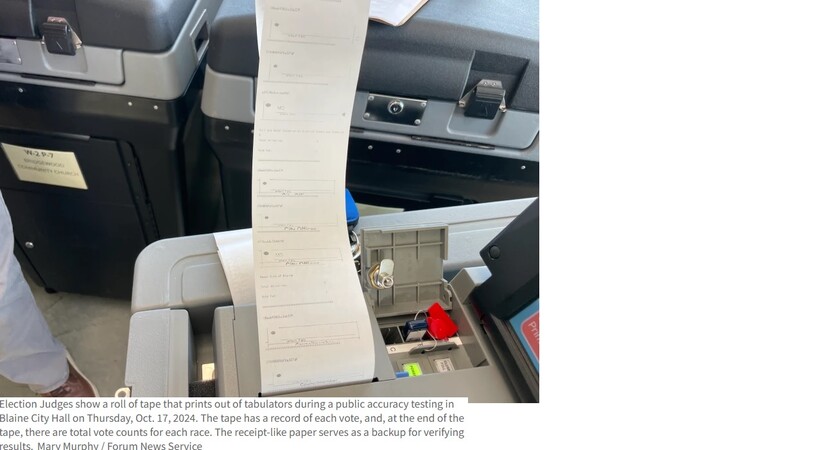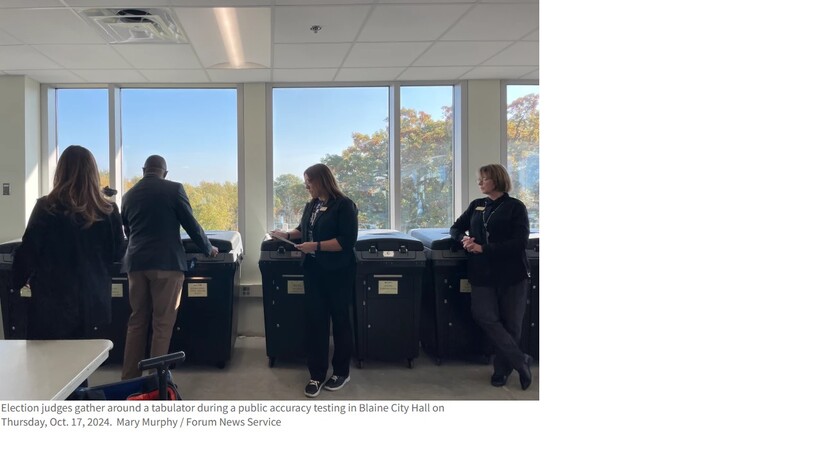Image


Anoka election officials and Minnesota Secretary of State Steve Simon conducted a public testing of voting tabulators on Thursday, the day before direct balloting started in Minnesota
BLAINE, Minn. — Minnesota Secretary of State Steve Simon and election officials from Anoka County gathered at Blaine City Hall on Thursday morning, Oct. 17, for a public testing of voting equipment ahead of the election.
“I’m here today to get out the truth that Minnesota’s elections are free, fair, secure and accurate, and you don’t have to take my word for it,” he said. “Events like these pull back the curtain on elections administration so that everyone can see how our system truly works.”
The public tests are required by Minnesota law, and are happening across the state in the days leading up to the election, Simon explained. But Anoka election judges noted they have already been testing these machines for weeks and hours.
The machines they tested, known as “tabulators,” are where every ballot — regardless of whether someone votes absentee or in person — is eventually inserted and counted. Simon said that any machine that does not perform perfectly will not be used in the election.

“They’re these things that look like trash cans but they’re not actually trash cans,” one of Anoka’s election judges said about the tabulators.
The judges tested three tabulators by inserting “test” ballots designed to trick the machines. They inserted creased ballots, blank ballots and ballots with writing in the wrong places to show how the machines rejected those.
On each tabulator, voters can see the vote count increase as the ballot is inserted. After ballots are counted, they stay in the tabulations until election judges eventually securely store them at county offices.
Ballots are kept for two years in case they’re ever needed — for a recount, for example — and after two years, they are shredded.
Minnesota state law also says the results recorded by the tabulators must be reported from each polling place to the county by some physical means, whether that is the disk from the machine or the receipt-looking tape that prints out of the tabulators with each vote.
Simon explained that Minnesota also has a strict “no internet” law to prevent tampering of results as they’re recorded, meaning the tabulators do not operate on any kind of internet connection.
The public testing was held one day before direct balloting started in Minnesota on Friday. Direct balloting, made legal this year under a new state law, allows people with absentee ballots to go to their election office and insert their ballot into the tabulator themselves. This is also when absentee ballots that have been accepted will begin being processed by tabulators.

The room at Blaine City Hall where the testing took place was blocked off by a wire fence that sported a sizable lock. The judges explained that ballots and tabulators are securely stored in locked rooms like this one.
As election judge Trace Ludewig inserted the test ballots, he explained what he’s told people when they have doubts about election security: “I tell them to come be an election judge, you’re actively involved in the process, you figure out there’s no way to cheat the system.”
Around a week after every election, when unofficial results have been submitted, all 87 counties conduct post-election reviews where they recount ballots from randomly selected precincts by hand. A precinct where 2,000 or more ballots were cast is allowed a 5-vote differentiation from what tabulators recorded. After this occurs, results are made official by the State Canvassing Board.

At the event, Simon directly addressed those who may consider disputing the results in November. He said that “it is every citizen’s right to go and challenge the results of an election,” adding, “They don’t have to believe what they’re told.”
Simon went on to say that concern over election security is what the court system is for.
“The courthouse doors are open. If you don’t like the result in district court, you can go to the court of appeals ... but when the last court has issued its last ruling, we’ve got to be done as Americans and Minnesotans,” he said.
Simon alluded to reactions from the 2020 election results across the country, saying that disputes should be solved in court and nowhere else.
“That’s where you fight it out, not on the streets, not by storming buildings,” Simon said. “We’ve got to accept the election results if, and especially if, it’s not a result that we might personally have wanted to see.”
To get answers to other common election security questions, read Forum News Service’s election Q&A.
SOURCE: Park Rapids Enterprise